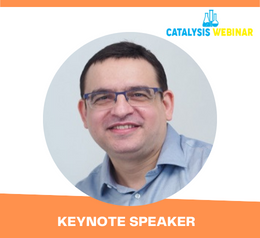Scholars International Webinar on
Catalysis, Chemical Engineering & Technology
THEME: "Contemporary Advances and Innovations in Catalysis and Chemical Engineering Research"
 25-26 Nov 2021
25-26 Nov 2021  Online | Virtual
Online | Virtual THEME: "Contemporary Advances and Innovations in Catalysis and Chemical Engineering Research"
 25-26 Nov 2021
25-26 Nov 2021  Online | Virtual
Online | Virtual 
Cardiff University, UK
Title: Catalysis on Particle-Stabilized Bubbles
Marc Pera-Titus is Professor & Chair of Sustainable Catalytic Chemistry at Cardiff University (Wales, UK). Marc received a double MSc degree in Chemical Engineering (2001) and Physical Chemistry (2002), and a PhD (2006) from University of Barcelona (Catalonia, Spain). In 2007, he joined Ircelyon/CNRS (France) as postdoc and was further appointed CNRS fellow in 2008. From 2011-2020, Marc was project leader, expert and deputy director at the E2P2L CNRS-Solvay joint laboratory in Shanghai (China), merging industrial and academic research. Marc is author of 125 papers and inventor of 16 patents in the fields of membranes, adsorption, catalysis and process eco-design. Marc has received numerous awards, including the Rhone-Alpes Foundation Award (2007), the Elsevier Award for highly cited author in Catalysis (2009), the Silver and Gold Medals from the Chinese Academy of Inventions (2016, 2017), the DivCat award from the French Society of Chemistry (2017) and a ERC consolidator grant (2018). Since 2021, he is elected fellow of the Royal Society of Chemistry.
Gas-liquid-solid
(G/L/S) reactions are ubiquitous in chemical, petrochemical and environmental
catalytic processes. Conventional G/L/S reactors comprise packed beds, stirred
tanks and bubble column slurry reactors. These technologies usually suffer from
mass/heat transfer limitations due to low G/L and L/S specific interface areas
and poor gas solubility. As a way out, herein we developed particle-stabilized
foams and bubbles in water and organic solvents as efficient G/L/S microreactors
for conducting diffusion-free catalytic reactions at low gas pressures.
First, we
prepared oil foams stabilized by surface-active silica particles bearing
fluorinated chains and Pd nanoparticles. Foamability increased with both the
particle concentration and stirring rate. High foam stability was achieved in
benzyl alcohol / xylene mixtures at very low particle concentration (<1 wt%)
for contact angles in the range 41-73°. The catalytic performance was strongly
affected by the foaming properties, with 8-times activity increase in pure O2
compared to non-foam systems. Particles were conveniently recycled with high
foamability and catalytic efficiency maintained for at least 7 consecutive
runs. Besides xylene, other solvents with surface tension lower than that of
the substrate could tune the particle wettability, enhancing the foamability
and catalytic performance in the aerobic oxidation reactions of a panel of
alcohols.
In a next step,
we engineered an on-purpose microfluidic tool to generate and test monodisperse
bubbles in solvents stabilized by fluorinated silica particles. Bubble
trapping and particle adsorption/desorption dynamics was studied using
fluorescent particles adsorbed at the air/oil interface. Accumulation of
particles at the back of bubbles was observed. When the confined bubbles left
to the wider channel, the interface relaxed and became circular with
redistribution of adsorbed particles. We compared the catalytic performance of
particle-stabilized bubbles using amphiphilic catalysts able to adsorb at the
G/L interface in model oxidation reactions, showing promising credentials
compared to stirred tank G/L/S reactors.